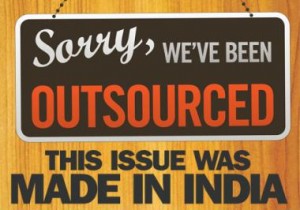In its second round of layoffs in just seven months, the Seattle Times said it will cut 130 to 150 positions, with the ax falling particularly hard on the newsroom. The cutbacks amount to less than 10% of the Times’ overall employment of, but the 35 to 45 positions lost in the newsroom represent 13% to 17% of the 260-person editorial staff. The publisher also vowed to continue to combine and consolidate sections to cut back on production costs. A buyout will be extended for less than one week, after which layoffs will begin.
Parent company Blethen has been desperately trying to cut costs in any way possible, including outsourcing trucking operations and trying to unload a chain of newspapers in Maine. There were reports late last month that a buyer for the newspapers has been found, but all has been quite for the two weeks since then. The Times cut more than 270 positions in April, and the scope of the new round indicates that the deteriorating economy is taking its toll. Indeed, the publisher said the advertising downturn has quickened with the plunging stock market and that even the one bright spot – online advertising – has flattened.
Rival and duopoly partner Post-Intelligencer says it plans no layoffs, but that company has been in an “ironclad” hiring freeze all year and has reduced headcount significantly through attrition. With this newest round of reductions, the Times will have reduced its total staff from 1,879 at the end of 2007 to no more than 1,469, a reduction of about 22% in a single year.
Layoff Log
- LA Times staffers are girding for yet another round of cuts, this time to the paper’s Washington bureau. An anonymous memo posted on Romenesko late last week claims to detail a meeting with Times D.C. Bureau Chief Doyle McManus in which McManus outlined plans for a consolidated Tribune Co. bureau structure with several papers sharing reporters. The bureau will consist of 24 people, which will require an unspecified number of layoffs, the memo said. This Friday was targeted as the date of the layoff announcement. McManus disputed some of the details of the memo in a posting on Romenesko, but basically affirmed plans for the consolidated bureau structure.
- The Frederick (Md.) News-Post will lay off 16 employees, including four in the newsroom. No word on what percentage of total employment that represents.
Miscellany
The Gannett Company continues to pointedly ignore a website created by a former employee, even as The Gannett Blog has become a major source of news about job cuts at the company. Now The New York Times has selected Gannett as a poster child of corporate cluelessness in this piece about transparency in the blogosphere. According to the Times, Gannett still refuses to return any inquiries from blog editor Jim Hopkins, despite the fact that the his posts consistently spark dozens or even hundreds of comments. In acting as a virtual water cooler for the entire company, Gannett Blog has become the destination of choice for employees who want to learn what’s really going on at Gannett because the company provides so little information about itself. As the Times notes, in an increasingly transparent business world, silence is no longer an option.
The publisher of The New York Times has a provocative opinion to share. Asked at a recent conference if newspapers will even exist in a decade, Arthur Sulzberger, Jr. responded, “We can’t care.” Those three words made the headline, but what Sulzberger was really saying was that the transition from print to digital media will proceed whether or not publishers want it. The Times’ recent moves to build a social network and to take down its paid registration wall are simply recognition of a changing media landscape, he said. Sulzberger believes print will have value far into the future and he chooses to look at the current turmoil in the industry as evolution rather than collapse.
And Finally…
 Who is this person to the left? If you were a fan of 1960s sitcoms, you’d know him as one of the most recognizable faces on television but he doesn’t look nearly the same today. Click here to find out. AOL’s Memba Them site has photos of 160 celebrities as you once knew them and shots of those same folks today. It’s a tribute to, er, aging gracefully!
Who is this person to the left? If you were a fan of 1960s sitcoms, you’d know him as one of the most recognizable faces on television but he doesn’t look nearly the same today. Click here to find out. AOL’s Memba Them site has photos of 160 celebrities as you once knew them and shots of those same folks today. It’s a tribute to, er, aging gracefully!







